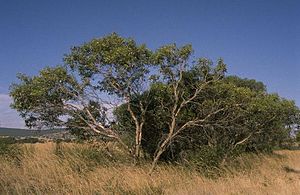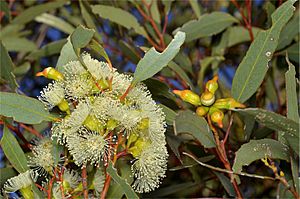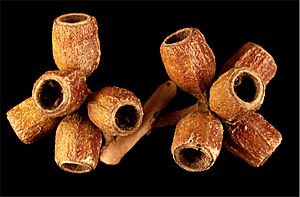Lerp mallee facts for kids
Quick facts for kids Lerp mallee |
|
|---|---|
 |
|
| Eucalyptus incrassata near Meningie - Coonalpyn in South Australia | |
| Scientific classification | |
| Genus: |
Eucalyptus
|
| Species: |
incrassata
|
| Synonyms | |
|
|
The Lerp Mallee (Eucalyptus incrassata) is a special type of eucalyptus tree that grows only in southern Australia. It's also known by other names like Yellow Mallee or Ridge-fruited Mallee. This tree has smooth bark, but sometimes it has rough, ribbon-like bark near its base. Its adult leaves are shaped like a spear. The Lerp Mallee produces flower buds in groups of seven. Its flowers can be creamy white, pale yellow, or sometimes even pink or red. After flowering, it grows fruit that looks like a cylinder, barrel, or bell.
Contents
What the Lerp Mallee Looks Like
The Lerp Mallee is a type of mallee tree. This means it often has many stems growing from the ground, like a bush, instead of just one trunk. It usually grows to be about 2 to 5 meters (6 to 16 feet) tall, but some can reach up to 10 meters (33 feet). It can also spread out, becoming 4 to 7 meters (13 to 23 feet) wide.
The bark on this tree is smooth and can be pink, grey, or brownish. Sometimes, near the bottom of the tree, you might see rough, grey or brown strips of bark. Young plants have dull, bluish-green leaves that are oval-shaped. These leaves are about 4 to 10 centimeters (1.5 to 4 inches) long.
Adult leaves are shiny green on both sides and are shaped like a spear. They are about 5 to 15 centimeters (2 to 6 inches) long and grow on a small stem called a petiole.
The flower buds grow in groups of seven. Each group is on a stalk about 1 to 2.8 centimeters (0.4 to 1.1 inches) long. The buds themselves are oblong or pear-shaped. They are about 1.1 to 2.3 centimeters (0.4 to 0.9 inches) long.
The Lerp Mallee blooms between August and April. Its flowers are usually cream-white or yellow. After the flowers, the tree produces a woody fruit. This fruit is shaped like a cylinder, barrel, or bell. It is about 1.1 to 2.3 centimeters (0.4 to 0.9 inches) long.
How the Lerp Mallee Got Its Name
The Lerp Mallee was first officially described by a botanist named Jacques Labillardière in 1806. He wrote about it in his book, Novae Hollandiae Plantarum Specimen.
The name incrassata comes from a Latin word that means 'thickened'. This name was chosen because the plant has thick leaves.
Where the Lerp Mallee Grows
The Lerp Mallee is often found on sandy plains and hillsides. It grows across many parts of southern Australia. You can find it in Western Australia, including the Mid West, Wheatbelt, Great Southern, and Goldfields-Esperance regions. It prefers sandy soils there.
It also grows in the south of South Australia, stretching into Victoria and New South Wales. This makes it one of the most common mallee species in Australia.
It often grows with other types of eucalyptus trees. The plants growing underneath these trees are usually shrubs like Melaleuca and Acacia. Sometimes, you might also see Triodia grasses.
Ecology and Life Cycle
This eucalyptus tree is very important for nature. It attracts birds and insects that eat nectar, which is a sweet liquid found in flowers. These animals also use the tree as a home.
Using the Lerp Mallee in Gardens and Farms
People use the Lerp Mallee for many things in gardens and on farms.
- It can be planted to create shade.
- Planting many of them together can form a good screen or privacy hedge.
- It helps stop soil from washing away (erosion control).
- It can act as a windbreak, protecting other plants or animals from strong winds.
This tree is good for gardens that have a Mediterranean or bush style. It also responds well to coppicing, which is a way of cutting the tree to encourage new growth.
The Lerp Mallee can handle both drought (very dry periods) and light frost. It can grow in regular soil or soil that has extra nutrients. It prefers to grow in full sun. Its seeds usually sprout in 2 to 6 weeks, and you can also grow new trees from cuttings.
Sometimes, the tree can get diseases. In wetter winter months, it might get powdery mildew, which looks like white powder on the leaves. It can also be affected by myrtle rust and a disease called dieback.
On farms, the Lerp Mallee can produce a lot of plant material, called biomass. This can be used for energy. It can produce about 10 to 20 metric tons per hectare each year. In farming areas, these trees are helpful because they can reduce salinity (too much salt in the soil). They also give shade to farm animals, act as windbreaks, and help reduce erosion.



